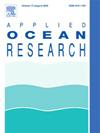An experimental benchmark study on shape effects of structures under forced vertical oscillation: Flow fields, wave radiation, and hydrodynamic coefficients
IF 4.3
2区 工程技术
Q1 ENGINEERING, OCEAN
引用次数: 0
Abstract
Floating structures play a crucial role in transitioning from fossil fuels to renewable energies, either in floating offshore wind, floating solar, or wave energy applications. However, an accurate and efficient determination of the floating structures’ motion in waves remains a challenging task, particularly in mid-fidelity applications or applications with the aim of real-time capabilities: In particular, evaluating viscous effects and their importance for hydrodynamic damping is crucial. The wave radiation damping is often deemed dominant for vertically oscillating structures, but viscous effects cannot be neglected. The underlying physical processes of such viscous effects are not fully understood due to a lack of high-quality three-dimensional experimental flow field data. The present study investigates structures under forced vertical oscillation and aims at enhancing the physical understanding of the relation between structural shapes and features, the hydrodynamic parameters and the flow field using 3D time-resolved flow field measurements from a particle tracking velocimetry system. These investigations lead to a benchmark dataset for the development and validation of sophisticated numerical models which is published alongside this study. Three different generic box-type shapes are investigated: (i) a sharp-edged box, (ii) a round-edged box, and (iii) a box with a heave plate at the bottom. The experimental results show strong shape effects on the hydrodynamic coefficients, wave radiation, and the flow field. The radiated wave height can differ up to 50% between the three structures. Viscous effects from vortex structures and separation lead to a -related increase of damping values for structures with sharp edges or heave plates. Significant shape effects on the vorticity are reported with a factor of up to 500% between the structures. Additionally to structural shape and features, the vorticity depends on and oscillation frequency, while the vortex size solely depends on and much less on structural shape (with a factor of up to 70%) and frequency. A comparison with potential flow simulations yields qualitatively good agreement to predict shape effects in added mass and radiation damping; however, a comparison between radiated wave heights from experiments and potential flow simulations indicates the necessity to validate potential flow results for quantitatively correct results.
受迫垂直振动下结构形状效应的实验基准研究:流场、波辐射和水动力系数
浮动结构在从化石燃料向可再生能源过渡的过程中发挥着至关重要的作用,无论是在浮动海上风能、浮动太阳能还是波浪能应用中。然而,准确有效地确定浮动结构在波浪中的运动仍然是一项具有挑战性的任务,特别是在中保真度应用或以实时功能为目的的应用中。特别是,评估粘性效应及其对水动力阻尼的重要性至关重要。波浪辐射阻尼通常被认为是垂直振动结构的主导因素,但粘性效应也不能忽视。由于缺乏高质量的三维实验流场数据,这种粘性效应的潜在物理过程尚未完全了解。本研究研究了受强迫垂直振荡的结构,旨在通过粒子跟踪测速系统的三维时间分辨流场测量来增强对结构形状和特征、水动力参数和流场之间关系的物理理解。这些调查为开发和验证复杂的数值模型提供了一个基准数据集,该数据集与本研究一起发表。研究了三种不同的通用箱型形状:(i)锐边箱,(ii)圆边箱,(iii)底部有鼓板的箱。实验结果表明,形状对水动力系数、波辐射和流场有较强的影响。三种结构的辐射波高相差可达50%。涡结构和分离产生的粘性效应导致具有尖锐边缘或隆起板结构的阻尼值与kc相关的增加。据报道,形状对涡度的显著影响在结构之间高达500%。除了结构形状和特征外,涡度与KC和振荡频率有关,而涡大小仅与KC有关,与结构形状和频率的关系较小(可达70%)。通过与势流模拟的比较,在质量和辐射阻尼的形状效应预测上得到了很好的一致性;然而,将实验所得的辐射波高与势流模拟所得的辐射波高进行比较表明,为了得到定量正确的结果,有必要对势流结果进行验证。
本文章由计算机程序翻译,如有差异,请以英文原文为准。
求助全文
约1分钟内获得全文
求助全文
来源期刊

Applied Ocean Research
地学-工程:大洋
CiteScore
8.70
自引率
7.00%
发文量
316
审稿时长
59 days
期刊介绍:
The aim of Applied Ocean Research is to encourage the submission of papers that advance the state of knowledge in a range of topics relevant to ocean engineering.
 求助内容:
求助内容: 应助结果提醒方式:
应助结果提醒方式:


